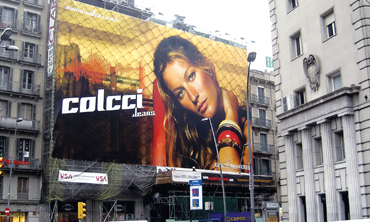Digital Printing
What’s Going On
Taking the pulse of the wide-format market
Published
17 years agoon

Significant “noise” characterizes the wide-format, digital-printing arena these days, as evidenced by the number of questions our digital experts field from potential, digital-equipment buyers. Inexperienced inquirers generally ask which printers offer the best combination of image quality, versatility, simplicity, reliability, speed, and, of course, purchase and operation costs.
Here’s the bottom line – numerous devices may meet most expectations, but very few will meet all of them. So, prospective buyers must ask the proper questions before choosing a printer. Equally important, the buyer should know what’s state-of-the-art or unique in order to optimize the purchase. This column will focus on new digital “stuff” and the technological trends that drive further development.
Upgrades have long enhanced high-end, wide- and grand-format printers, but many questions we now receive address printers in the $15,000 to $100,000 range. Most technological trends, however, tend to encompass all digital-print devices.
Resolution gains
Face it folks, evaluating a print through “intended viewing distance” is an anachronism. Formerly, you could coerce your customer into examining his fleet graphic from 40 ft. away to determine print quality. If you were particularly adept, the customer could be convinced to make a decision while looking at a moving vehicle. Now, buyers take out a printer’s loop when evaluating a banner that features drink specials at the local Mexican restaurant.
AdvertisementPrint resolution is a competitive battleground – anything less than 720 dpi may put your shop at a competitive disadvantage. Manufacturers are exceeding 1,440 dpi through continued printhead development, precise alignment and faster, more powerful computers.
Further improvements in inks, such as nanotechnology, or the ability to provide sub-micron pigment particles, allow printers to lay down considerably smaller drop sizes through printheads with more nozzles. Some printer manufacturers have even eliminated the 360-dpi option, which isn’t necessarily bad, because printer output at higher resolution continually improves.
Fast printing
Faster-drying inks, and printers that dry more effectively, have allowed print speeds to improve, complemented by printheads that deliver more ink. Higher-speed printheads are now standard equipment on several models from numerous manufacturers; in some cases, nozzles per head have quadrupled from 360 to 1,440.
Mimaki USA’s JV5 series of solvent printers further focuses on speed by offering four, high-speed heads, in a staggered array, that advance the media four times further with each carriage scan. The JV5 also offers consistent color application in whatever direction the carriage moves. This can reduce color-shift banding previously associated with bi-directional printing. Ultimately, improved ink and head technology allows higher quality in faster print modes – a very good thing.
Advertisement
Better color gamut
Signshops are perhaps the most prolific adopters of digital-printing technology. In many cases, they must produce graphics with corporate colors or match existing, cut-vinyl jobs, where color accuracy is paramount. As inks continue to evolve, improved color gamut allows more colors, which yield more vivid results (think tomato red).
Six-, eight-, and 12-color printers are now common, but printers achieve true gamut enhancements through the addition of colors such as violet and green. Gerber Scientific Products’s Solara UV2 is an example – it runs CYMKVG to meet sign manufacturers’ needs. Our test results encouragingly show that many expanded-gamut inks match CMYK outdoor durability. This proves pigment selection remains a high priority for most ink vendors.
Further, third-party ink vendors will stay, because they provide credible alternatives to OEM inks. Many such vendors offer plug-and-play, OEM color-matched systems, as well as an expanded gamut that exceeds the OEM ink sets’ color performance.
Solvent inks rule outside
In today’s market, solvent-ink vendors describe their products as “heavy,” “rugged,” “eco,” “mild” and “true.” Regardless of nomenclature, all emit some degree of potentially harmful VOCs — many are considered hazardous materials. From a media manufacturer’s perspective, solvent inks have improved to become more compatible with vinyl-based substrates.
AdvertisementBut, variables still exist that impact these inks’ outdoor durability, abrasion and chemical resistance, drying time and adhesion to multiple substrates. Our chemists marvel that solvent-ink use remains widespread, given OSHA and EPA restrictions. However, most ink alternatives possess their own limitations.
UV-curable inks have gained versatility, but popular versions don’t match solvent ink’s adhesion and flexibility. We’ve tested UV-curable inks, as part of our ICS-certification process, that show remarkable outdoor durability. HP's UV-cure inks used in its DisplayMaker series are the first inks we’ve found that exceeded our five-year standard for outdoor durability.
Inkware’s corn-based solvent inks offer a promising digital-ink innovation. Promoted by |2324| as BioVu™ and Mutoh as MutohBio™, these inks diffuse much safer VOCs and contain no solvents the EPA designates as hazardous.
According to EFI-Vutek, they’re 100% biodegradable, ozone-safe, non-carcinogenic and, perhaps best of all, made from renewable resources. They require no special media, and should have drying, color-gamut, print-speed and durability characteristics similar to well-known solvent inks.
Also, waterbased inks that mimic solvent-ink performance, without the need for treated or coated media, remain in development. However, reliable sources have told me these inks may exist sooner rather than later.
Flatbeds everywhere
Digital-printing trend discussions must acknowledge flatbed printers’ proliferation. Using primarily UV technology, these machines print direct to rigid substrates and fit nicely into a screenprinting shop’s flow. The technology is cheaper than a few years ago — excellent machines exist that cost considerably less than $100,000. Printing multiple substrates facilitates producing more digital jobs more cheaply.
Also, printing directly to the substrate eliminates lamination and mounting, and reduces scrap generated in finishing and handling the graphics. Though reduced costs are hard savings, there’s a softer side to printing direct-to-substrate on a flatbed. Jobs printed on glass, louvered doors, ceiling tiles and other unique substrates allow graphics providers a broader repertoire in their selling kit.
Time to buy?
Evolving technology adds purchasing risks – many buyers are anxious – something newer, faster and better looms just around the corner. Go to a tradeshow and count how many times you hear something is “coming soon.” Some major players tout new products that will take digital printing to the next level, but their timeframes are iffy. Compared to the last few years, now seems like an excellent time to buy a digital printer. Resolution enhancements may reach the point of diminishing returns.
Today, improved print speeds exceed what most service providers require to work efficiently. And, superior image quality and color accuracy grow in tandem with print speeds. Prices for hardware and software, which continually become more user-friendly, have dropped, and competition rages. Additionally, ink performance has stabilized, if not improved, and most major media vendors have determined how to fine-tune their digital-media products for optimal results.
SPONSORED VIDEO
Introducing the Sign Industry Podcast
The Sign Industry Podcast is a platform for every sign person out there — from the old-timers who bent neon and hand-lettered boats to those venturing into new technologies — we want to get their stories out for everyone to hear. Come join us and listen to stories, learn tricks or techniques, and get insights of what’s to come. We are the world’s second oldest profession. The folks who started the world’s oldest profession needed a sign.
You may like
Advertisement
Subscribe

Magazine
Get the most important news
and business ideas from Signsofthetimes Magazine.
Advertisement
Most Popular
-

 Tip Sheet4 days ago
Tip Sheet4 days agoAlways Brand Yourself and Wear Fewer Hats — Two of April’s Sign Tips
-

 Business Management2 weeks ago
Business Management2 weeks agoWhen Should Sign Companies Hire Salespeople or Fire Customers?
-

 Real Deal5 days ago
Real Deal5 days agoA Woman Sign Company Owner Confronts a Sexist Wholesaler
-

 Women in Signs2 weeks ago
Women in Signs2 weeks ago2024 Women in Signs Award Winners Excel in Diverse Roles
-

 Benchmarks2 days ago
Benchmarks2 days ago6 Sports Venue Signs Deserving a Standing Ovation
-

 Editor's Note1 week ago
Editor's Note1 week agoWhy We Still Need the Women in Signs Award
-

 Women in Signs5 days ago
Women in Signs5 days ago2024 Women in Signs: Megan Bradley
-

 Line Time2 weeks ago
Line Time2 weeks agoOne Less Thing to Do for Sign Customers












